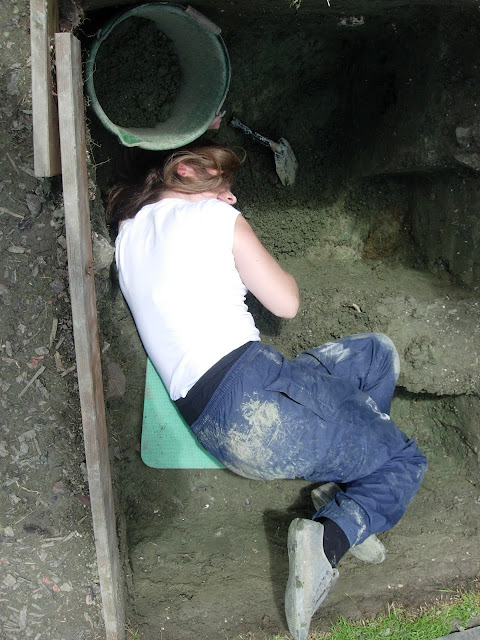This week we've braved the blazing sunshine and oppressive heat to continue with our third keyhole. We returned to the property we did the first keyhole in to excavate the foundations for a garden wall, but this time in the back garden. Work had been done here previously in 2011 so we knew there may be something of interest and indeed there was!
As usual we start by preparing the site...
...and begin to trowel...
....having an occasional break to take in the view...
.....but it all seems a bit natural...
....until we come across this ditch feature...

...and further investigation confirms our suspicions...
..so there we have it, a pair of legs in a ditch underneath someones garden.
Yes it is more common than you think.
They look broken at the top but that is post-depositional (happened after burial) and do not indicate trauma.
I'm sure you are all wondering how, where, what, why so I'll give you my thoughts on the matter. In the Iron Age (or the time there abouts) it seems that the standard practise of disposing of dead people of lower ranks was in ditches or pits. The Iron Age people who lived in Britain loved their ditches and digging them then filling them with rubbish (which did include people!) seemed to be something of a national past time. That's not to say graves and even cemeteries are not unheard of but the evidence currently points to the majority of the population being buried in this fashion.
We still have some important questions to consider:
Did the body go in whole? Possibly. Again it's not unheard of in this period to find bits of people rather than a whole skeleton raising questions over how people were treated after death. Some believe that the body was allowed to decompose in the open air before being interred (we generally refer to these as 'Sky burials' and was used in the British Isles during prehistory; it was also used by the Native Americans and is still practised in Tibet today). Maybe the legs were separated from the rest of the body, perhaps through amputation or warfare? Unlikely as there seems to be no obvious trauma to the legs ie. no blade/saw marks which you'd get if they had been hacked off. Maybe the answer lies in the present day and I believe, if there indeed was an upper body, then when the ground was levelled at the back of the house then it was probably removed then; the legs have been protected by the slope which you can see in the photo above. Anything is possible!
What happens to it once lifted? All human remains require a licence from the Home Office to lift; it is illegal to remove skeletons without the licence. Now it's out of the ground it will go to be washed and analysed by our lovely osteologist (human bone specialist) at CAT and she'll see if there is anything of note. After that the bones will either be stored at the Folkestone People's History Centre or, hopefully, at the new museum which we hope will be with us very soon! Otherwise the bones will be re-buried in a suitable location (they can not return to the property and do not belong to the owners of the house).
So there you have it. Another exciting test pit discovery. I'll keep you posted on the results from processing.
Any questions or theories please do share.
...to be continued...





























